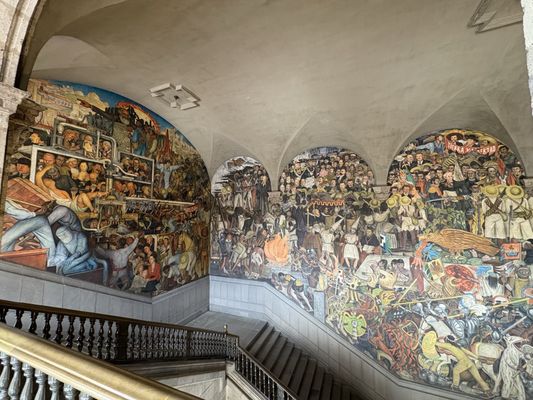National Palace
Seat of Mexican government featuring stunning Diego Rivera murals
Information
P.za de la Constitución S/N, Centro Histórico de la Cdad. de México, Centro, Cuauhtémoc, 06066 Ciudad de México, CDMX, Mexico Get directions
Seat of Mexican government featuring stunning Diego Rivera murals






























P.za de la Constitución S/N, Centro Histórico de la Cdad. de México, Centro, Cuauhtémoc, 06066 Ciudad de México, CDMX, Mexico Get directions

"Diego Rivera's famous mural "The History of Mexico," showcases the history of the nation, from the Aztec era through the conquest to the Revolution and the development of industry. It's grandiose and captivating, a unique opportunity to learn about Mexico's past through art. Not to mention it's free: The mural is housed in a distinguished building east of the Zócalo that operates as a government office. Among the office workers milling about, you'll see a mix of local, national, and international tourists who come to be awe-stricken by Rivera’s masterpiece." - Scarlett Lindeman, Susannah Rigg


"A distinguished building east of the Zócalo holds (for free!) (to the public!) (in open air!) some of the most stunning Diego Rivera murals in his canon. The building operates as the seat of the federal executive branch of Mexico’s government, so there are office workers milling about and you have to check your bag and show identification before entering the building. But once you turn the corner and come face to face with Rivera’s masterpiece you'll be awestruck. Diego Rivera's famous mural The History of Mexico showcases the Aztec era to the conquest to the Revolution to the development of industry. It's grandiose and captivating, a unique opportunity to learn about Mexico's past. Note that sometimes the building will close at odd hours during the day when there are visiting dignitaries and what not. Make sure and find out when they're open and time your visit. You can't miss this." - Scarlett Lindeman


"A historic governmental and cultural complex housing important murals and exhibits that reflect national history and heritage, located in the city's central district." - Lauren Dana Ellman Lauren Dana Ellman Lauren Dana Ellman is a New York-based writer and editor who specializes in travel, lifestyle, food, and shopping content. Travel + Leisure Editorial Guidelines

"I visited the Palacio Nacional as one of Mexico City's free attractions and enjoyed its cultural and historical offerings." - Lauren Dana Ellman Lauren Dana Ellman Lauren Dana Ellman is a New York-based writer and editor who specializes in travel, lifestyle, food, and shopping content. Travel + Leisure Editorial Guidelines

"Palacio Nacional is the seat of the Mexican government (the flag floating atop of it will tip you off), and is one of the most impressive buildings in CDMX, but it’s inside where you’ll find the good stuff, like the murals painted by Diego Rivera. The murals retrace the history of the country and were painted between 1929 and 1951. If muralism is your jam and you want to see more examples of it, head to the Museo Mural Diego Rivera located just beside Alameda Central Park, just a 20-minute walk from the National Palace." - MATADOR_NETWORK